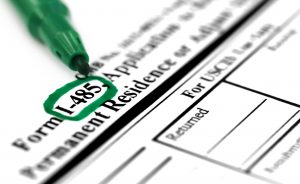What is AC21?
Background:
- In 2000, Congress enacted the American Competitiveness in the Twenty-First Century Act of 2000[1] (AC21) which, in part, added INA 204(j)
- This provision allows certain employment-based adjustment of status applicants experiencing delays in the employment-based adjustment of the status process some flexibility to change jobs or employers while their Application to Register Permanent Residence or Adjust Status (Form I-485) is pending
“If eligible under INA 204(j), the Immigrant Petition for Alien Workers (Form I-140) (and underlying permanent labor certification, if applicable) may remain valid and the beneficiary of an approved employment-based immigrant visa petition in the 1st, 2nd, or 3rd preference category may transfer, or “port,” to a qualifying new job offer that is in the same or a similar occupational classification as the job offer for which the petition was filed. The new job offer may be through the same employer that filed the petition or a different employer”.
“These provisions are referred to as “portability.” Employment-based adjustment applicants who use such benefits are considered to have “ported” the petition filed on their behalf to the new job offer”.
What Types of Jobs are “Portable?”
How Can I Use the Same Priority Date?
General Portability Requirements
To qualify for portability under INA 204(j), the adjustment applicant must meet the following eligibility requirements:
- The applicant is the beneficiary of an approved Form I-140 petition or of a pending petition that is ultimately approved
- The petition is filed in the employment-based 1st, 2nd, or 3rd preference category
- The applicant’s properly filed adjustment application has been pending with USCIS for 180 days or more at the time USCIS receives the request to port
- The new job offer through which the applicant seeks to adjust status is in the same or similar occupational classification as the job specified in the petition
- The applicant submitted a request to port
- The new job offer maybe with the same petitioner or with an entirely new employer, including self-employment
- Applicants can submit the portability request and evidence with the adjustment application or in any in-person interviews or in response to a request or other notice from USCIS
Note:
- If the applicant makes a request to “port” on or after January 17, 2017, the applicant must submit a Confirmation of Bona Fide Job Offer or Request for Job Portability Under INA Section 204(j) (Form I-485 Supplement J)
- If the applicant requested to port before January 17, 2017, the applicant could have requested to port through a letter, since Form I-485 Supplement J did not go into effect until January 17, 2017
Is Approved Petition Required?
-
- If USCIS has approved an applicant’s Form I-140 petition and the applicant’s adjustment application remained unadjudicated for 180 days or more (from the adjustment application receipt date), the approved petition remains valid unless the petition’s approval is later substantively revoked
- This applies even if the applicant changes jobs or employers so long as the new offer of employment is in the same or similar occupation
- However, If the adjustment application has been pending for less than 180 days, the approved petition cannot be ported for new employment
- In all cases, an offer of employment must have been bona fide and the employer must have had the intent (at the time the petition was approved) to employ the beneficiary upon adjustment
In case of revocation, the officer adjudicating the adjustment application may deny the adjustment application and Supplement J request.
What if the Petition is Withdrawn by My Previous Employer?
-
- If USCIS receives a request from a petitioner to withdraw a pending Form I-140 petition, USCIS issues an acknowledgment of the withdrawal request and denies any corresponding adjustment application
- However, if the pending petition is approvable and the adjustment application was pending for 180 days or more, the petition may remain valid for priority date retention and possible eligibility under INA 204(j) for the adjustment application.[7]
However, If the adjustment applicant is not eligible under INA 204(j), the applicant must obtain a new employment-based preference petition in order to file a new adjustment application, even if the withdrawal of the original petition occurred after it had been approved for at least 180 days or a corresponding adjustment application was pending for at least 180 days.
When Does the Countdown Start for 180 Days?
The counting the number of days the adjustment application has been pending begins on the day the applicant properly filed the adjustment application with USCIS and includes every subsequent calendar day until USCIS receives the applicant’s request to port (so long as the application remains unadjudicated).
What is the Purpose of I-485 Supplement J and the AC-21 Portability Process?
- The purpose of I-485 Supplement J is to provide a confirmation of the bona fide job offer (during initial I-485 filing) or to inform USCIS in I-485 porting cases under AC-21 (for pending I-485 cases)
Who Needs to File Form I-485 Supplement J?
- For all new I-485 filings where it is used to confirm that the job offered in the underlying I-140 immigrant petition (pending or approved) is still valid and offered to the beneficiary
- All requests for AC21 portability of pending I-485 applications where the beneficiary wishes to transfer their pending I-485 to a new employer or job which is “same or similar”
Is it Necessary For My I-485 Application to be Pending for More than 180 days if I have an Approved I-140?
- Although USCIS cannot deny your I-485 application on the sole basis that you left your employer before 180 days have passed
- USCIS can issue a request for evidence (RFE) to determine whether the original offer of employment was bonafide
- Your sponsor’s support could be necessary to respond to the RFE and its refusal to cooperate could mean denial of your I-485 application
How to Determine If a New Job is in Same or Similar Occupational Classification?
“To determine whether a new job offer is valid for purposes of INA 204(j) portability, the new job offer must be in either the same occupational classification or a similar occupational classification as the job specified in the underlying Form I-140 petition”.
Same Occupational Classification
- An occupation that resembles in every relevant respect the occupation for which the underlying employment-based immigrant visa petition was approved.[17]
- Accordingly, USCIS evaluates whether the jobs are identical, resembling in every relevant respect, or the same kind of category or thing when determining whether two job offers are in the same occupational classification
Similar Occupational Classification
- An occupation that shares essential qualities or has a marked resemblance or likeness with the occupation for which the underlying employment-based immigrant visa petition was approved.[18]
- When determining whether two job offers are in similar occupational classifications, USCIS evaluates whether the jobs share essential qualities or have a marked resemblance or likeness
In order to determine if the new job offer is in the same or similar occupational classification as the job listed on the petition, officers evaluate various factors.
Relevant Factors Include:
- The U.S. Department of Labor (DOL) occupational codes assigned to the respective jobs;
- Job duties
- Job titles
- The required skills and experience
- The educational and training requirements
- Any licenses or certifications specifically required
- The offered wage or salary
- Any other material and credible evidence relevant to a determination of whether the new position is in the same or a similar occupational classification
Note: A change to the same or a similar occupational classification may involve lateral movement, career progression, or porting to self-employment, either in the same or a different geographic location.
Should I Keep both I-485 and H1-B/L1 or H4?
It is also great to have both H1-B, L1, or H4, and I-485 if possible. It is a great contingency, if there is a sudden job loss or the possibility of being out of status, immediate availability of an EAD and AP would definitely help you avoid any violations.
We wrote a blog on that topic which might help you make a decision. You can find that blog here
Portability rules are complex. Contact a reliable immigration attorney to ensure a safe transition to your new employment.
If you have questions about the adjustment of status or have questions about the Green Card procedure in general, you can schedule a consultation with us:
Schedule a call at 469-994-9407 or contact us using the form.
Due to popular demand (and a few e-mails from people who could not join the H-1B webinar I hosted a few weeks ago), I decided to have another H-1B CAP webinar on February 25, 2021, at 12pm (CST).
I will cover the following topics:
- H-1B Registration
- Information about the selection process
- H-1B Requirements for the Employer and the Employee
- Tips to avoid an RFE
- Considerations for OPT students
- Q &A
If you are interested, and could not make the previous webinar, you can register here:




